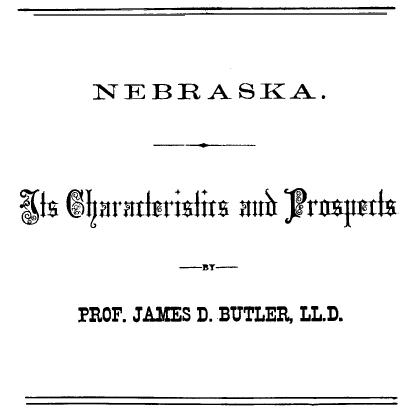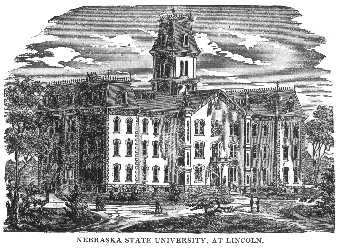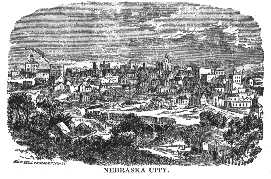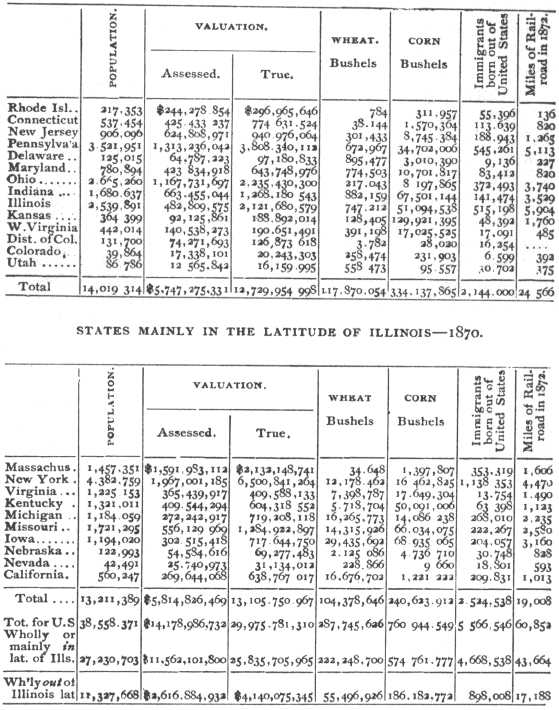
Corner-stone laid September, 1869; edifice
completed December 1870; cost $152,000.

Opened for instruction September, 1871. Students during the first year about one hundred.

Corner-stone laid September, 1869; edifice
completed December 1870; cost $152,000.

Opened for instruction September, 1871. Students during the first year about one hundred.

NEBRASKA has no sublime scenery. No lake, cliff, cave or cataract. Still less can it boast of glacier, avalanche, geyser or volcano, ruins or other antiquities. It stretches four hundred miles up the side of the Rocky Mountains. Yet that slope is not rocky, and nowhere appears mountainous to the eye. The wonders of the Yellowstone were once here, but they have been carried away into Montana by the omnipotence of Congress. Long regarded as a mysterious Sahara, it has now lost even that gloomy attraction. Forty of its pioneers were scalped in 1864; but to save the Indians from extinction has ever since been harder than it ever had been to kill them. Elk, antelope and buffalo long crowded its prairies, but this glory is fast fading away.
An eloquent writer, in the North American Review for July, 1858, when there was scarcely one Nebraska hamlet forty miles west of the Missouri, treated of the United States as having "already reached their western inland frontier," and the "westward stream of emigration as there dammed up," so that it must "fork northward or southward-towards Canada or New Mexico. The prairie tablelands which lie back of the Missouri bluffs" were declared "not capable of much cultivation." "Periodical inundations" were said "to render permanent improvements impracticable in the Platte River bottom."
Entered according to Act of Congress, in the year 1873, by G. S. HARRIS, in the office of the Librarian of Congress at Washington.
Reprinted by the NEBRASKA STATE HISTORICAL SOCIETY, Lincoln, Nebraska, 1974
4
Nebraska, accordingly, was described as a "shore at the termination of a vast ocean-desert, nearly one thousand miles in breadth, and interposing a final barrier to the establishment of large communities - agricultural, mercantile, or even pastoral."
These doctrines were orthodox fifteen years ago, but myriads now pronounce Nebraska worthy to be sought, as the best of new homes, by every man who leaves his old one. The object of the following article is to prove this assertion true, from the history of American settlements, from the objectives of Western migration, from the courses of Railroad lines, from the Nebraska soil and climate, from the progress already made, from sectional diversities of industry, as well as from the situation and nature of markets.
The statistics, with which my paper bristles, have cost me labor in gleaning, and will be as hard for some to peruse as for me to procure. Too many readers are twin brothers of that Turkish Emir, who, in answer to Layard's inquiries, wrote : "The thing you ask me is both difficult and useless. Although I have passed all my days in this place, I have neither counted the houses nor inquired into the number of the inhabitants and as to what one person loads on his mules, and the other stows away in his ship, that is no business of mine. But above all is Heaven! God only knows what dirt and confusion the infidel may have eaten before the coming of the Sword of Islam. Oh! my lamb! seek not after the things which concern thee not."
For such anti-political-economists this paper is not intended, but for progressive, calculating men, who love nothing so well as the logic of facts and figures, to prove how they can better their condition.
Within those latitudes there lie eleven States and three territories, with an aggregate population of more than fourteen millions. Within the same limits we find more than half the area, or at least the population, of ten other States, the inhabitants of which, in 1870, numbered more than thirteen millions. Among our fourteen cities which have a census of over 100,000, New Orleans alone is far from the Illinois latitude, and only two others are so among the twenty-five cities having each a census of over 50,000.
5


© 1998, 1999, 2000, 2001 for the NEGenWeb Project by T& C Miller
Feb 1999